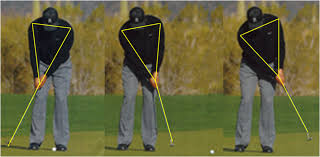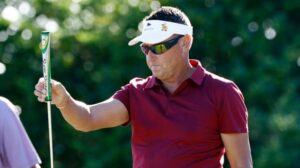Putting can account for almost half of the strokes for every round of golf that you play. Last week our Swing Tip was about CONTROLLING your body for full swing shots. Putting is a whole new ballgame. You only have one chance to make every putt so both your Mental and Physical CONTROL are critical to be a good putter.
Make your putts release in a straight line:
a. Swinging to impact your ball on the dead center of the putter face for a straight release.
b. Avoid side spin by swinging straight up your target line at the point of impact to avoid side spin.
Great putters are CONFIDENT about their target line and their feel for the right swing distance to pass the hole. To build your confidence in every putt, try these 4 swing tips.
1/ Choose Your Direction: Determine your target direction based on your best estimate for the amount of break that you expect for your putt to reach 12 inches beyond the hole. If you can’t see the break, use your “calibrated” putter to plumb-bob the break at the hole (ref.: https://golfstr.com/weekend-warriors-strategy-putting/).
It is absolutely amazing that your putting confidence will be UNSHACKABLE when you know the direction of the break of your putt on a green with a 1 degree side slope. Learn the 5 second trick to Plumb-Bob the slope of each green as your ball approaches the hole. Missing a putt by a quarter of an inch is devastating.

Keep your eyes focused straight down as you rock your shoulders to putt straight up your target line. Moving your head will distort the direction of your putt.
2/ Practice Your Swing to Feel the Distance: Use practice swings for the exact swing that you feel will hit your ball 12 inches past the hole (to avoid both the extra break as your ball slows down and indentations on the green near the hole). In your practice swing you are accounting for the distance that your ball will travel uphill or downhill. Mentally count “1” as you rock your shoulders back and “ 2” as you rock your shoulders forward through impact for the right distance to reach your target.
3/ Stare at Your Target Point: Burn your target point into your brain. You know the direction that you want to start your putt. Extend that point out to 12 inches beyond the hole. Stare at the extended point for 2 to 3 seconds to lock that direction and distance image in your brain. [You are not staring at the hole, you are staring at the point 12 inches beyond the hole on your target line. That point creates an optical illusion that burns into your brain for the distance of your putt.]
4/ Stare at Your Ball: Duplicate the same putting stroke as your last practice swing but hit your ball DEAD CENTER ON THE FACE OF YOUR PUTTER as you swing straight up your target line without moving your head to follow the path of your ball.
Use these Mental IMAGES to practice putting with a locked leading wrist using your GOLFSTR+. Buy one today at www.golfstr.com






